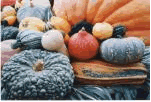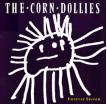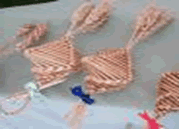HARVEST FESTIVAL

The
goldenrod is yellow
The corn is turning brown
The trees in apple orchards
With fruit are bending down.
Children’s song
Celebrations for a successful harvest are very ancient.
In
England, thanks have been given for successful harvests
since pagan times. This day is celebrated by singing, praying and decorating
the churches with baskets of fruit and food in a festival known as 'Harvest
Festival', usually during the month of September.
Harvest Festival reminds Christians of all the good
things God gives them. This makes them want to share with others who
are not so fortunate. In schools and in Churches, people bring food
from home to a Harvest Festival Service. After the service, the food
that has been put on display is usually made into parcels and given
to people in need.
When
is Harvest Festival?
Harvest festivals are traditionally held on or near the Sunday of the
Harvest Moon. This moon is the full moon which falls in the month of
September, at or around the time of the Autumnal Equinox, about Sept.
23. Unlike the USA and Canada, the UK does not have a national holiday
for Harvest Festival
History
of Harvest Festival - Traditions and Customs
Harvest Festival used to be celebrated at the beginning
of the Harvest season on 1 August and was called Lammas, meaning 'loaf
Mass'. Farmers made loaves of bread from the new wheat crop and gave
them to their local church. They were then used as the Communion bread
during a special mass thanking God for the harvest. The custom ended
when Henry VIII broke away from the Catholic Church, and nowadays we
have harvest festivals at the end of the season Farmers celebrated the
end of the harvest with a big meal called a harvest supper, eaten on
Michaelmas Day. This was rather like a Christmas dinner, but as turkeys
were unknown at that time, a goose stuffed with apples was eaten. Goose
Fairs are still held in some English towns, but geese are no longer
sold.
The tradition of celebrating Harvest Festival in churches
as we know it today began in 1843, when the Reverend Robert Hawker invited
parishioners to a special thanksgiving service for the harvest at his
church at Morwenstow in Cornwall. Victorian hymns such as "We plough
the fields and scatter", "Come ye thankful people, come"
and "All things bright and beautiful" helped popularise his
idea of harvest festival and spread the annual custom of decorating
churches with home-grown produce for the Harvest Festival service.
Corn Dollies
The making of corn dollies goes back many thousands
of years. It was a Pagan custom and evolved from the beliefs of the
corn growing people who believed in the Corn Spirit.
 |
 |
Corn
dollies were made at Harvest time
from the last sheaf of corn cut. The Corn Spirit was supposed to live
or be reborn in the plaited straw ornament or corn doll and was kept
until the following spring to ensure a good harvest. The corn dolly
often had a place of honour at the harvest banquet table.
The craft was brought to a halt by the advent of mechanization in the
1800s, but is now being revived as a fascinating hobby
ACTIVITIES
After reading the text about Harvest Festival and Corn Dollies, try to do this ACTIVITY and this VOCABULARY QUIZ.